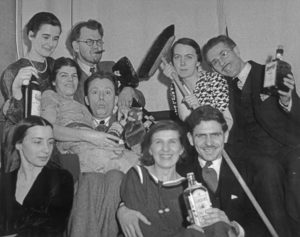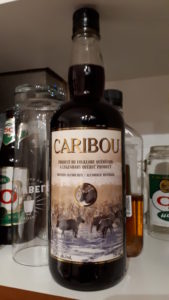Elections, levees, and moose milk: New Year’s Day traditions in Canada

A New Year’s Eve party, somewhere in Canada in the 1930s. Who could continue celebrating on New Year’s Day after a wild night like this? Photo: Charles Comfort/Library and Archives Canada, 1995-019 DAP. Copyright expired.
To many, New Year’s Eve and New Year’s Day are a big deal with parties containing abundant amounts of food and drink. To some of us, our observance of the roll-over of numbers on the world’s odometer is more benign. We may have a slightly more interesting dinner than usual for a Monday night or a drink of something otherwise reserved for special occasions. Other than that, our New Year’s exercise involves putting up the new calendars, usually obtained for free from a local business—or in exchange for a donation to our favorite public radio station.
Canadian New Year’s Eve and day observances vary, much like they do among people and communities in the United States.
Decades ago in Ontario, New Year’s Day was municipal election day. Voters, who were probably tired or feeling ill from late-night celebrating, would go to the polls and choose new town or city councils, school board trustees, and utility commissioners. In The People’s Power, the history of Ontario Hydro by Merrill Denison, it is explained how voters in many towns and cities marked ballots on New Year’s Day during the first half of the 20thCentury to authorize local governments to create municipal power utilities and connect with the provincial transmission system as a source of electricity.
Another political tradition, that is still very much alive, especially in English-speaking communities is the annual New Year’s Levee. They are receptions held by mayors, legislators, military officers, religious leaders, provincial lieutenants-governor, and the Governor-General of Canada on or close to New Year’s Day.
The levees go back to the French and British colonial times. The word levee is taken from the French verb lever, “to rise.” Louis XIV of France (the “sun king”) would begin each day with the levée du soleil (rising of the sun). He would receive his male subjects in his bedroom before getting out of bed in the morning.
In Great Britain, Ireland, and in the new world leaders preferred not to meet their constituents in bed.
The levee in 18thCentury Britain was a late-morning or afternoon reception held by the king or queen for men only with the women being presented at a separate reception in the evenings.
In France’s and Britain’s colonies, the levee was held by the governor as he was the representative of the monarch. The masters of fur-trading forts began holding levees as well. The first New Year’s Levee in New France was held on January 1, 1646 by governor Charles Huault de Montmagny.
Today, the New Year’s levees are public events which are informal. They’re especially common in the more traditional English parts of Canada. Anyone may attend. Food and drinks are served.
On Prince Edward Island, levee is a day-long affair, with some events starting as early as 8 am. In Kingston, Ontario, the Anglican Bishop of the Diocese of Ontario holds a levee. In Niagara-on-the-Lake where the Niagara River enters Lake Ontario, a cannon is fired, and residents gather for multiple toasts outdoors. In eastern Ontario, levees are held at the city halls in Kingston and Brockville.

A bottle of Caribou from a Quebec government liquor store. Photo: James Morgan
One of the more common beverages served at levees is “moose milk,” a bad translation from French of sang de caribou, or “caribou blood.” Nobody is really drinking milk from a moose or caribou blood though. Voyageurs however did drink the latter because it kept them warm in harsh winter conditions.
The contemporary adaptation of moose milk or caribou is red wine or port mixed with pure alcohol or whiskey and maple syrup. It can be served hot or cold with spices added, like mulled wine. The beverage can be homemade, but in Quebec, the provincial liquor corporation sells a bottled version at its stores.
New Year’s Day in my family was always a bit dull. One of my grandmothers, whenever she lived nearby, always thought it was important to have a big dinner late in the afternoon. She always went to a great effort, but I always remember everyone being tired at those events.
In my immediate family, it was the day to take down Christmas decorations at the instigation of my Mom, who quickly grew tired of them “cluttering up the house.” This was often done to the dismay of Dad, who recalled the tradition of keeping everything up until Epiphany, or “Old Christmas.”
I’m going to take New Year’s Eve and day easy this year. It’s time to clean up clutter and maybe spend some time outside enjoying nature. May everyone have a healthy, peaceful, and joyful 2019.








James,
Interesting bit of history. There are so many of these kinds of stories it would be interesting to find out other peoples New Years experiences.
Thanks, Tom